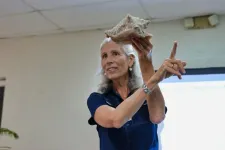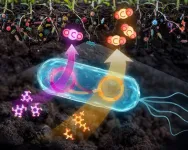(Press-News.org) When the COVID-19 pandemic hit, it sent shock waves across global supply chains. But manufacturers and other businesses weren’t the only ones hit hard: local and international aid organizations, tasked with providing humanitarian assistance during times of crisis, suddenly had a major crisis of their own. How would they get the supplies they needed to carry out their crucial work?
According to a new study by the UBC Sauder School of Business, the organizations showed remarkable nimbleness and ingenuity — and while the pandemic was an unusual event, their approaches can provide powerful insights for businesses and non-profits facing adversity.
For the study, the research team interviewed 15 supply chain and logistics managers, field coordinators and supply chain specialists working in large humanitarian organizations including the World Health Organization, UNICEF, Doctors Without Borders and CARE International, as well as smaller, more local, non-profits. Some were focused on emergency response, while others prioritized long-term aid. The team also gathered data from secondary sources such as company websites, news databases and standard operating procedures.
The researchers found that when COVID arrived, the non-profits experienced the same spike in demand for medications, PPE and other pandemic-related supplies as for-profit operations while working in already highly challenging environments.
“Suddenly humanitarian organizations needed PPE for all of their employees instead of just nurses and doctors,” explains UBC Sauder School lecturer and study co-author Samuel Roscoe, who previously worked in the aid sector. The provision of mental health support also abruptly ended in many areas, and supply to feeding centres was disrupted.
“If you’re delivering aid to an internally displaced persons camp where you already have malaria, cholera and all of these other communicable diseases, and then all of a sudden COVID comes along, it becomes almost impossible to operate or deliver medical assistance.”
The different types of organizations responded differently to supply chain shocks. Long-term development organizations — especially those with ties to international bodies such as the UN, the World Bank and the IMF — were able to source from multiple suppliers and create backup arrangements. And rather than send bids out to tender, they focused on the handful of suppliers that were capable of fulfilling orders and secured long-term contracts.
“So if they contacted a supplier of PPE they would say, ‘We plan to purchase X amount of products from you, and we want you to commit that you'll provide them,” says Roscoe. “It meant they were locked into these suppliers, and they had a regular supply even during 2020 and 2021 when a lot of organizations didn't. So that was a big advantage.”
Some organizations found themselves tangled in donor contracts, where private donors or governments had earmarked funds to a particular disaster, so they couldn’t allocate those funds to their COVID response. “All of a sudden they had to go back to donors and say, ‘Are you ok if we use 20 or 30 per cent of your budget to buy PPE or administer vaccines?’” says Roscoe. “So that created a lot of delays in their response. Some even had to renegotiate contracts.”
Air travel was disrupted and the price of shipping containers and other forms of long-distance transport skyrocketed, so instead of purchasing items in Europe and then shipping to the Middle East or Africa, many organizations began buying from local grocery stores or regional warehouses or distributors.
“There were many logistical challenges, but they found they could continue to deliver aid by using local suppliers — and that worked as an emergency response because they could find the products they needed,” explains Roscoe. “It wasn't always enough, so it did create some shortages. But that was one of their big pivots.”
Non-profits that were the most flexible in their organizational structures and had more decentralized decision-making fared better, adds Roscoe, because employees could make important decisions without going through layers of management. Similarly, groups that were in communication with volunteers and communities on the ground were better able to meet the needs of those they were serving.
Organizations that had good relationships with national or regional governments were also better able to function during the pandemic. For example, UN organizations were able to continue delivering aid during lockdowns, whereas Doctors Without Borders, which purposefully distances itself from authorities, had more trouble getting permission to travel or go into displaced person camps.
The study is the first of its kind to look at how aid organizations operate during co-occurring crises, such as wars, natural disasters and a pandemic.
While the findings are instructive for the non-profit sector, Roscoe says they’re also relevant to for-profit businesses. The study provides a roadmap on how to build the dynamic capabilities that business leaders need to compete in uncertain operating environments.
“These organizations are designed around providing aid in difficult situations, and when their situation got even more difficult, they still found ways to cope, whereas a lot of businesses that aren’t designed for flexibility and responsiveness struggled,” says Roscoe.
“If your organization is built around responsiveness and flexibility, it will be better able to withstand any degree of crisis, whether it’s a low-level crisis like a supplier shutting down or a major crisis like a pandemic, and your people will find a way to adapt and adjust much more quickly.”
END
Humanitarian organizations showed flexibility and grit during COVID supply chain disruptions: study
2024-06-11
ELSE PRESS RELEASES FROM THIS DATE:
Research on the visual rabbit illusion takes a leap forward
2024-06-11
Fukuoka, Japan—Researchers from Kyushu University have uncovered new variations to a traditional illusion, based on how we perceive the motion of flashing lights. Published on May 21 in i-Perception, the findings show that when three light flashes are presented in rapid succession in our side vision, our brain tends to perceive them in a straight line, with the second flash around the midpoint, no matter the actual location of the second flash. This research, which earned the journal’s Early Career Best Paper Prize this year, offers new perspectives on perceptual errors ...
Virus-like nanoparticles control the multicellular organization and reproduction of host bacteria
2024-06-11
Tsukuba, Japan—Viruses are ubiquitous in the environment, and organisms have developed various mechanisms to counter their threat. However, the genome of actinomycetes contains a highly conserved gene set encoding virus-like nanoparticles, although its biological significance has remained unclear.
In this study, researchers examined Streptomyces davawensis, an actinomycete species, and discovered that it produces virus-like particles that facilitate host reproduction. Extracellular DNA, which serves as a scaffold for multicellular organization, was significantly reduced in the colonies of mutant S. davawensis strains ...
Origins of fast radio bursts come into focus through polarized light
2024-06-11
TORONTO, ON, June 11, 2024 — What scientists previously thought about where Fast Radio Bursts (FRBs) come from is just the tip of the iceberg, according to new research led by astronomers at the University of Toronto. The mysteries of the millisecond-long cosmic explosions are unfolding with a new way of analyzing data from the Canadian Hydrogen Intensity Mapping Experiment (CHIME).
Published today in The Astrophysical Journal, the study details the properties of polarized light from 128 non-repeating FRBs — those from sources that have ...
Press registration opens for ACS Fall 2024
2024-06-11
WASHINGTON, June 11, 2024 — Journalists who register for the fall meeting of the American Chemical Society (ACS) will have access to about 10,000 presentations on topics including agriculture and food, energy and fuels, health and medicine, sustainability, and more. ACS Fall 2024 is a hybrid meeting being held virtually and in person in Denver on Aug. 18-22, with the theme “Elevating Chemistry.”
ACS considers requests for press credentials and complimentary meeting registration from reporters (staff and freelance) and public information officers at government, nonprofit and educational institutions. Please ...
New plasma escape mechanism could protect fusion vessels from excessive heat
2024-06-11
The furious exhaust heat generated by a fusing plasma in a commercial-scale reactor may not be as damaging to the vessel’s innards as once thought, according to researchers at the U.S. Department of Energy’s (DOE) Princeton Plasma Physics Laboratory (PPPL), Oak Ridge National Laboratory and the ITER Organization (ITER).
“This discovery fundamentally changes how we think about the way heat and particles travel between two critically important regions at the edge of a plasma during fusion,” said PPPL Managing Principal Research Physicist Choongseok Chang, who led ...
Endocrine Society urges passage of the Right to IVF Act
2024-06-11
WASHINGTON—The Endocrine Society endorses the Right to IVF Act, which was introduced by Senators Cory Booker (D-NJ), Patty Murray (D-WA) and Tammy Duckworth (D-IL) to protect and expand nationwide access to fertility treatment, including in vitro fertilization (IVF), and urges the Senate to pass the Right to IVF Act on June 12th to ensure that the freedom to start and grow a family is protected and accessible to everyone in the United States.
Infertility affects an increasing number of individuals. ...
FAU Harbor Branch launches ‘eConch’ to grow and conserve the queen conch
2024-06-11
The queen conch (Aliger gigas) is a prized delicacy long harvested for food and revered for its beautiful shell. With a lifespan between 25 to 40 years, the queen conch is second only to the spiny lobster fishery and is the most important molluscan fishery in the Caribbean region.
Deeply rooted in the way of life in the Caribbean, many island communities depend on queen conch for their livelihoods. However, intensive fishing and habitat degradation from urbanization and climate change have caused conch populations ...
Surprisingly high levels of toxic gas found in Louisiana
2024-06-11
The toxic gas ethylene oxide, at levels thousand times higher than what is considered safe, was detected across parts of Louisiana with a cutting-edge mobile air-testing lab. The concentrations found dwarfed Environmental Protection Agency estimates for the region.
The findings, led by Johns Hopkins University environmental engineers, suggest significantly higher cancer risks for people who live near facilities that manufacture and use ethylene oxide, as well as a need for more accurate and reliable tools to monitor emissions.
“I don’t think there’s any census track in the area that wasn’t at higher risk for cancer than we would deem acceptable,” said ...
Soil bacteria respire more CO2 after sugar-free meals
2024-06-11
When soil microbes eat plant matter, the digested food follows one of two pathways. Either the microbe uses the food to build its own body, or it respires its meal as carbon dioxide (CO2) into the atmosphere.
Now, a Northwestern University-led research team has, for the first time, tracked the pathways of a mixture of plant waste as it moves through bacteria’s metabolism to contribute to atmospheric CO2. The researchers discovered that microbes respire three times as much CO2 from lignin carbons (non-sugar aromatic units) compared to cellulose carbons (glucose sugar units), which both add structure and support ...
Human evolution and online morality
2024-06-11
In a Review article, Claire Robertson and colleagues explore how human morality, which evolved in the context of small in-person groups, functions on the internet with over five billion users. Evolved human responses, such as compassion for victims and urges to punish transgressors, operate differently online, the authors argue. The internet exposes users to large quantities of extreme morally relevant stimuli in the form of 24-hour news and intentionally outrageous content from sometimes physically distant locations. Subjecting human brains to this ...






